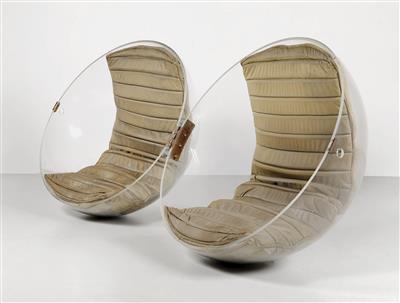A rare seat object for two, designed by Danilo Silvestrin *,

1969, for Gunther Lambert, Germany, two acrylic glass hemispheres, metal hinges, foam cushions covered with metal-coated fabric, diameter (closed) approx. 110 cm. (DRAX)
The only known example of this model. The seat object, consisting of two hinged hemispheres, can be closed to form a sphere and locked. Acrylic glass balls at the bottom prevent the object from sliding. The cushions are attached by snap fasteners and weighted down with lead inserted at the bottom.
Lit.:
“Apollo 12 für den Hausgebrauch”, in: Der Stern, no. 29, 20 July 1969, pp. 68–74 – Schöner Wohnen, 8/70, pp. 64/65 (Silvestrin’s apartment) – Kontraste. Dortmunder Kameraskizzen von Horst Thielbeer, 1969 – Design Made in Germany, Cologne 2000, pp. 76/77, fig. 67– G. Siekmann, “zum mond gestartet, im wohnzimmer gelandet. einflüsse der weltraumforschung auf das design von alltagsobjekten und möbeln in den sechziger jahren”, in: Vergangene Zukunft. Design zwischen Utopie und Wissenschaft, Vienna 2001, pp. 30–34, fig. 3
Exhibited:
Vision 2000, Popdom, Cologne 2000 – Design Made in Germany, Cologne 2001 – Vergangene Zukunft. Design zwischen Utopie und Wissenschaft, Kunsthalle Krems, 2001
Provenance:
private ownership, Germany
In the 1960s and 1970s, the Italian architect Danilo Silvestrin was a successful interior designer in Germany who promoted a radically modern approach in line with the utopian living concepts of his time. In Lambert, whose company exclusively specialized in acrylic glass products, he found a producer for his unconventional furniture designs. Silvestrin was a close friend of the artists of the Zero group and also used paintings by Uecker, Luther, and Mack for the apartments he designed. Together with these artists, he was also involved in the interior decoration of the legendary Creamcheese music club in Düsseldorf.
In the age of utopian space travelling, the form of the sphere, because of its complex symbolism, perfectly correlated with the new attitude towards life, which sought to leave conventional housing behind. Silvestrin especially appreciated acrylic glass or Perspex as a material, for its transparency made man “finally the center of his dwelling”, as he said.
20.06.2017 - 18:00
- Prezzo realizzato: **
-
EUR 45.000,-
- Stima:
-
EUR 36.000,- a EUR 45.000,-
A rare seat object for two, designed by Danilo Silvestrin *,
1969, for Gunther Lambert, Germany, two acrylic glass hemispheres, metal hinges, foam cushions covered with metal-coated fabric, diameter (closed) approx. 110 cm. (DRAX)
The only known example of this model. The seat object, consisting of two hinged hemispheres, can be closed to form a sphere and locked. Acrylic glass balls at the bottom prevent the object from sliding. The cushions are attached by snap fasteners and weighted down with lead inserted at the bottom.
Lit.:
“Apollo 12 für den Hausgebrauch”, in: Der Stern, no. 29, 20 July 1969, pp. 68–74 – Schöner Wohnen, 8/70, pp. 64/65 (Silvestrin’s apartment) – Kontraste. Dortmunder Kameraskizzen von Horst Thielbeer, 1969 – Design Made in Germany, Cologne 2000, pp. 76/77, fig. 67– G. Siekmann, “zum mond gestartet, im wohnzimmer gelandet. einflüsse der weltraumforschung auf das design von alltagsobjekten und möbeln in den sechziger jahren”, in: Vergangene Zukunft. Design zwischen Utopie und Wissenschaft, Vienna 2001, pp. 30–34, fig. 3
Exhibited:
Vision 2000, Popdom, Cologne 2000 – Design Made in Germany, Cologne 2001 – Vergangene Zukunft. Design zwischen Utopie und Wissenschaft, Kunsthalle Krems, 2001
Provenance:
private ownership, Germany
In the 1960s and 1970s, the Italian architect Danilo Silvestrin was a successful interior designer in Germany who promoted a radically modern approach in line with the utopian living concepts of his time. In Lambert, whose company exclusively specialized in acrylic glass products, he found a producer for his unconventional furniture designs. Silvestrin was a close friend of the artists of the Zero group and also used paintings by Uecker, Luther, and Mack for the apartments he designed. Together with these artists, he was also involved in the interior decoration of the legendary Creamcheese music club in Düsseldorf.
In the age of utopian space travelling, the form of the sphere, because of its complex symbolism, perfectly correlated with the new attitude towards life, which sought to leave conventional housing behind. Silvestrin especially appreciated acrylic glass or Perspex as a material, for its transparency made man “finally the center of his dwelling”, as he said.
|
Hotline dell'acquirente
lun-ven: 10.00 - 17.00
kundendienst@dorotheum.at +43 1 515 60 200 |
| Asta: | Design First |
| Tipo d'asta: | Asta in sala |
| Data: | 20.06.2017 - 18:00 |
| Luogo dell'asta: | Wien | Palais Dorotheum |
| Esposizione: | 10.06. - 20.06.2017 |
** Prezzo d'acquisto comprensivo di tassa di vendita e IVA
Non è più possibile effettuare un ordine di acquisto su Internet. L'asta è in preparazione o è già stata eseguita.
Lotti da altre aste
- Deutsch Ostafrika
- Leopold I.- XV/15 Kreuzer Münzstätten Graz, St. Veit und Hall
- Poststück - IGLAU - extreme Vielfalt an Belegen von Tschechosl. ab 1918 bis in die Protektoratszeit,
- Koloman Moser, zwei Postkarten: Deutscher Schulverein 1880, Karte Nr. 101 und 103, Kunstdruckerei Josef Eberle, Wien VII, Schottenfeldgasse 88, Wien, um 1910
- Paar zankende Amoretten, in der Art von Jean Baptiste Pigalle (1714-1785), 20. Jahrhundert
